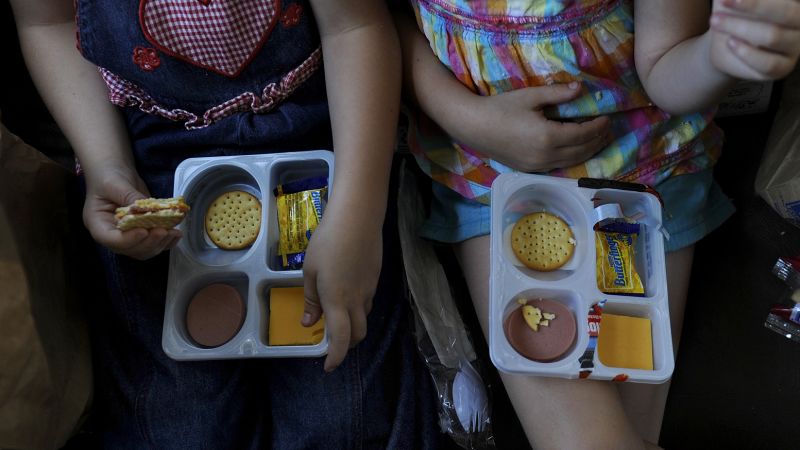Lunchables are going to be rolled out directly to students. Here’s what’s in them

New York
CNN
—
Kraft Heinz has succeeded in getting its ready-to-eat packaged Lunchables into school lunch programs starting this fall, in a major new initiative. But the company had to reformulate the ingredients to ensure the products meet federal guidelines first.
This would mark the first time Lunchables are directly entering schools, the company told CNN Business Tuesday. Kraft Heinz said the new products will be available nationwide to all school administrators to procure and offer to students either for purchase in the lunchroom – though the company did not disclose the cost to schools – or for free through the National School Lunch Program (NSLP).
In addition to rolling out Lunchables in schools, the company said it’s also testing the addition of packaged Lunchables fruits for sale in stores later this year, “with the potential to scale nationally in 2024.”
A Kraft Heinz
(KHC) executive, speaking at the annual Consumer Analyst Group of New York conference on Feb. 21, first announced that the company was preparing to deliver its packaged ready-to-eat Lunchable kids meals directly to students by putting them in school cafeterias.
Carlos Abrams-Rivera, an executive vice president with Kraft Heinz, said two new varieties of Lunchables (separate from Lunchables sold in grocery stores), with “improved nutrition” that comply with the NSLP requirements, will be served in K-12 schools nationwide, beginning this fall.
While Abrams-Rivera didn’t provide further details, a company website appeared to show the new products.
Kraft Heinz described on its website, Kraft Heinz Away From Home, the Lunchables products that it said are “built for schools” and “now meet NSLP” guidelines. The NSLP, established in 1946, provides lunch daily to nearly 30 million students in public and nonprofit private schools and residential child care institutions.
The information posted on Kraftheinzawayfromhome.com describes two products as new for the 2023-24 school year and built for the lunchroom “but are also great for field trips, summer school and dinner programs. One of the main selling points for schools is that the Lunchables for schools don’t need to be frozen, but kept refrigerated, “minimizing [school] labor needs and costs.”
The packaging for the turkey and cheddar Lunchables option is described as a 3.5 ounce container. The document said it contains 2-ounce equivalents MMA (meat/meat alternative), one ounce equivalent of grain and “meets whole grain rich criteria” of the NSLP. Kraft Heinz said Tuesday that it contains 6g of saturated fat and 930mg of sodium.
The extra cheesy pizza option comes in a 5.05 ounce container and contains 2 ounces equivalent of MMA, 2 ounce equivalents of grain, 1/8 cup of red/orange vegetable, 7g of saturated fat, 700 mg of sodium and “meets whole grain rich criteria” of the NSLP.
Kraft Heinz said both options were made using “a specialized recipe that incorporates more protein and whole grains to keep kids powered throughout the day, reduced saturated fat and sodium, and an increased serving size.”
The idea to roll out Lunchables in schools comes amidst new proposed changes to school food guidelines by the US Department of Agriculture, which oversees the federally assisted school meal program.
The proposed changes aim to reduce added sugars and sodium levels in school-provided lunches. The standards would reduce sodium limits gradually over several school years.
While school meals are paid for by local and federal funding, the standards for what goes on a kids’ cafeteria tray are set by the USDA.
The agency’s job is to make sure any meal served at school is nutritious and falls in line with the US Dietary Guidelines. Schools are mandated to offer students five meal components – fruit, vegetable, protein, grain and milk – and students must take at least three (and one has to be a fruit or vegetable) as part of their lunch.
Lauren Au, assistant professor at UC Davis’ Department of Nutrition who studies the effectiveness of school nutrition programs, said she would want to know the sodium, saturated fat and added sugar content in the reformulated Lunchables to determine if they are a beneficial addition to school lunches.
“Research shows that high intakes of sodium will over time increase the risk of developing high blood pressure and other diseases,” said Au. “The concern also is that young kids who are exposed to high sodium in packaged foods early in life could develop a preference for high sodium foods throughout their lives.”
The Lunchable Turkey & Cheddar Cheese with Crackers (3.2 ounce) tray sold in Target, for example, contains 740 mg of sodium in the one packet serving size. According to the Dietary Guidelines for Americans, adults should limit sodium intake to less than 2,300 mg per day—that’s equal to about 1 teaspoon of table salt. For children under age 14, the recommended limits are even lower.
Au said the cost of the Lunchables for schools interested in procuring them is something else that would come into play. “From the cost standpoint, I would be concerned that these might be more expensive than meals currently available and offered in the NSLP,” she said.
Meghan Maroney, federal child nutrition programs campaign manager at the Center for Science in the Public Interest (CSPI), said “Kraft Heinz has been promoting it for a while now to school and state organizations,” she said.
Maroney said she’s also interested in learning about the complete nutritional makeup of the two Lunchable products to determine if they fully meet the current and proposed NSLP nutritional guidelines.
“Also, if the products are reformulated to meet NSLP guidelines, they will taste different from Lunchables sold in stores because of lower sodium, saturated fat and other requirements. This can be confusing for kids,” Maroney said.
But offering Lunchables in school cafeterias might be welcome in some school districts that are struggling with higher food costs and labor shortages, said Diane Pratt-Heavner, spokesperson for the School Nutrition Association, a trade group with 50,000 members representing school food service providers.
“As school nutrition guidelines get increasingly complex, we’ve seen companies leaving the K-12 segment, said Pratt-Heavner. “It’s good to see a company interested in selling to this segment. But I would see Lunchables as one of a couple of meal options, and not that schools are getting away from offering a daily hot meal option.”
Kraft Heinz is a partner of the School Nutrition Association.
– CNN’s Jen Christensen contributed to this story







